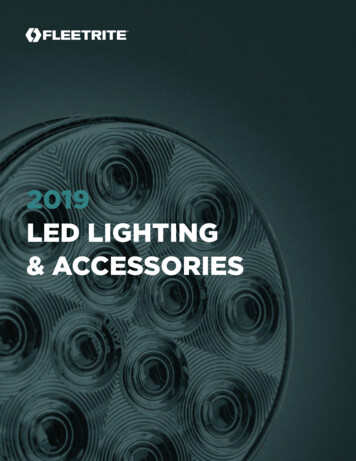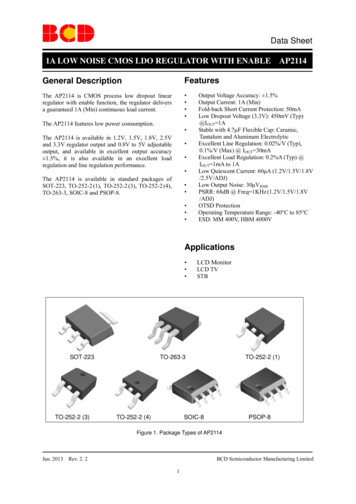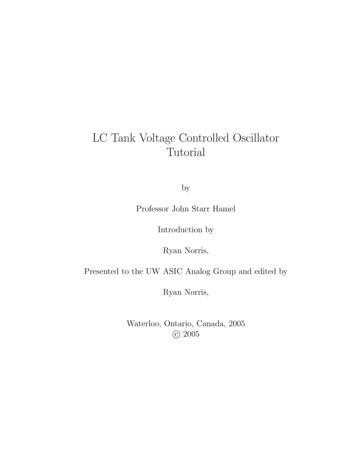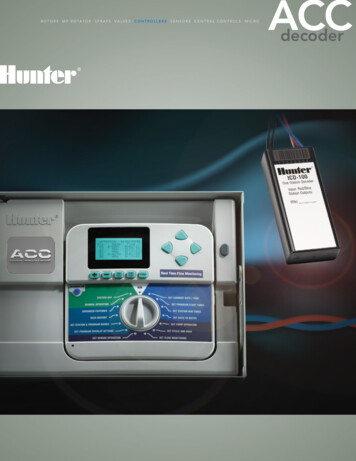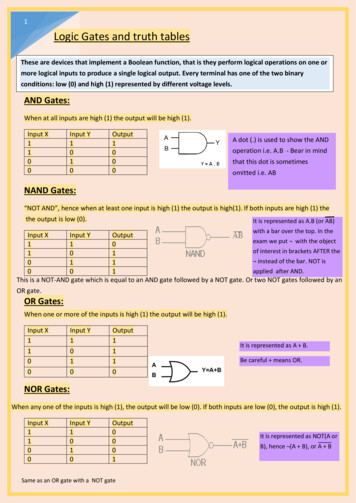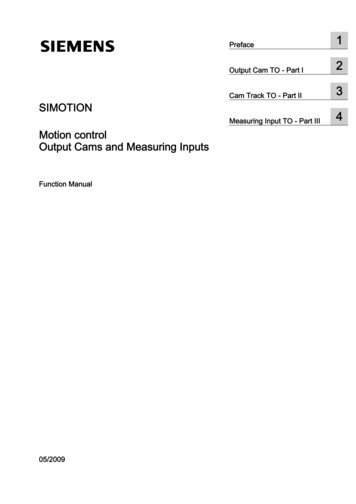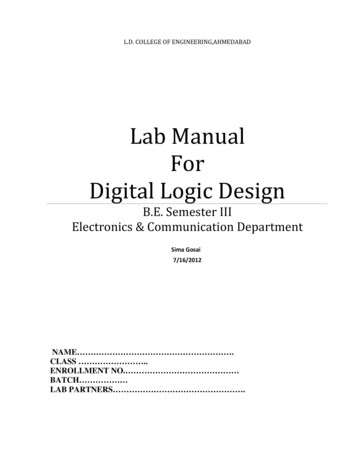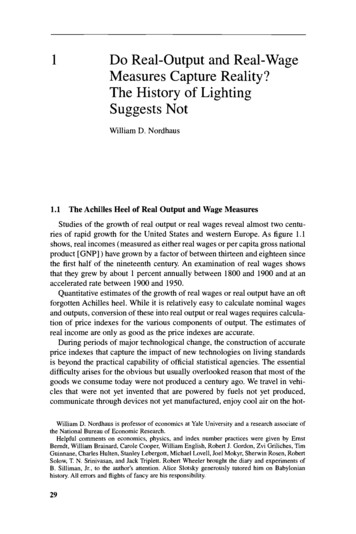
Transcription
1Do Real-Output and Real-WageMeasures Capture Reality?The History of LightingSuggests NotWilliam D. Nordhaus1.1 The Achilles Heel of Real Output and Wage MeasuresStudies of the growth of real output or real wages reveal almost two centuries of rapid growth for the United States and western Europe. As figure 1.1shows, real incomes (measured as either real wages or per capita gross nationalproduct [GNP] ) have grown by a factor of between thirteen and eighteen sincethe first half of the nineteenth century. An examination of real wages showsthat they grew by about 1 percent annually between 1800 and 1900 and at anaccelerated rate between 1900 and 1950.Quantitative estimates of the growth of real wages or real output have an oftforgotten Achilles heel. While it is relatively easy to calculate nominal wagesand outputs, conversion of these into real output or real wages requires calculation of price indexes for the various components of output. The estimates ofreal income are only as good as the price indexes are accurate.During periods of major technological change, the construction of accurateprice indexes that capture the impact of new technologies on living standardsis beyond the practical capability of official statistical agencies. The essentialdifficulty arises for the obvious but usually overlooked reason that most of thegoods we consume today were not produced a century ago. We travel in vehicles that were not yet invented that are powered by fuels not yet produced,communicate through devices not yet manufactured, enjoy cool air on the hotWilliam D. Nordhaus is professor of economics at Yale University and a research associate ofthe National Bureau of Economic Research.Helpful comments on economics, physics, and index number practices were given by ErnstBerndt, William Brainard, Carole Cooper, William English, Robert J. Gordon, Zvi Griliches, TimGuinnane, Charles Hulten, Stanley Lebergott, Michael Lovell, Joel Mokyr, Sherwin Rosen, RobertSolow, T. N. Srinivasan, and Jack Triplett. Robert Wheeler brought the diary and experiments ofB. Silliman, Jr., to the author’s attention. Alice Slotsky generously tutored him on Babylonianhistory. All errors and flights of fancy are his responsibility.29
30William D. Nordhaus1800-18501900Real wages 19502000p. c. GNPFig. 1.1 Real wages and per capita GNPtest days1 are entertained by electronic wizardry that was not dreamed of, andreceive medical treatments that were unheard of. If we are to obtain accurateestimates of the growth of real incomes over the last century, we must somehow construct price indexes that account for the vast changes in the qualityand range of goods and services that we consume, that somehow compare theservices of horse with automobile, of Pony Express with facsimile machine, ofcarbon paper with photocopier, of dark and lonely nights with nights spentwatching television, and of brain surgery with magnetic resonance imaging.Making a complete reckoning of the impact of new and improved consumergoods on our living standards is an epic task. The present study takes a smallstep in that direction by exploring the potential bias in estimating prices andoutput in a single area-lighting. This sector is one in which the measurementof “true” output is straightforward but where misleading approaches have beenfollowed in the construction of actual price or output indexes. The bottom lineis simple: traditional price indexes of lighting vastly overstate the increase inlighting prices over the last two centuries, and the true rise in living standardsin this sector has consequently been vastly understated.The plan of this paper is as follows: I begin with an analysis of the history oflighting, focusing particularly on the revolutionary developments in this field. Ithen use data on lighting efficiency to construct a “true” price of light andcompare this with “traditional” price indexes that are constructed using traditional techniques. In the final section I engage in a Gedankenexperiment onthe extent to which revolutionary changes in technology may lead to similarI . The revolutionary implications of air-conditioning are considered in Oi, chap. 3 in thisvolume.
31Do Real-Output and Real-Wage Measures Capture Reality?biases for other consumer goods and services and the consequent underestimation of the growth of real incomes over the last century.1.2 Milestones in the History of Light1.2.1 Basic Measurement ConventionsI begin with some simple conventions. What we call “light” is radiation thatstimulates the retina of the human eye. Radiation in the visible spectrum comprises wavelengths between 4 X lo-’ and 7 Xmeter. Light flux or flowis the name for the rate of emission from a source, and the unit of light flux isthe lumen. A wax candle emits about 13 lumens, a one-hundred-watt filamentbulb about 1200 lumens, and an eighteen-watt compact fluorescent bulb about1290 lumens. The unit of illuminance (the amount of light per unit area) is thelux; one lux equals one lumen per square meter. Unobstructed daylight provides about ten thousand lux, while the level of illuminance of an ordinaryhome is about one hundred lux. In the candle age, a room lit by two candleswould enjoy about five lux.The efficiency of a lighting device can be measured in many ways, but formy purposes I am interested in the light output per unit of energy input. Thisis measured either as lumen-hoursper thousand Btu (British thermal units), oralternatively today as lumens per watt.1.2.2 EvolutionThe first and in some ways most spectacular stage in the development ofillumination is the eye itself, which evolved to exploit that part of the spectrumin which the sun (and moon) concentrate the greatest part of their radiatedenergy. Having adapted to daylight, the next stage for prehistoric humans wasto devise means to illuminate the night, or dwellings like caves. The history oflighting reveals primarily the extraordinarily slow evolution in technology forthe first few million years of human societies and then the extraordinarily rapiddevelopment from about the time of the Industrial Revolution until the earlypart of this century.1.2.3 Open FiresThe first use of artificial or produced light probably coincided with the controlled use of fire. The first tool, known as the Oldowan chopper, has beendated from 2.6 million years ago, while the tentative identification of domesticated fire used by Australopithecus was discovered in Africa and dates from1.42 million years ago. More definitive evidence of the controlled use of firewas found in the caves of Peking man (Homo erectus) dating from around500,000 years ago. Presumably, open fires were used partially as illuminantsin caves. It seems likely that sticks were used as torches in early times. (Seetable 1.1 for a brief chronology of the history of lighting.)
32William D. NordhausTable 1.11,420,000B.C.500,000 B.C.38,000-9000 B.C.3000 B.C.2000 B.C.1292Middle s18821920s1930s19311980sMilestones in the History of LightingFire used by AustralopithecusFire used in caves by Peking manStone fat-buming lamps with wicks used in southern EuropeCandlesticks recovered from Egypt and CreteBabylonian market for lighting fuel (sesame oil)Paris tax rolls list 72 chandlers (candle makers)Tallow candles in wide use in western EuropeDiscovery of Argand oil lampWilliam Murdock uses coal-gas illumination in his Comwall homeWilliam Murdock uses coal-gas illumination in Birmingham officesCandle technology improved by the use of stearic acid, spermaceti, andparaffin waxGas street lighting installed in Pall Mall, LondonBenjamin Silliman, Ir., experiments with “rock oil”Demonstration of electric-discharge lamp by the Royal Society ofLondonDevelopment of kerosene lampsWilliam Wallace’s 500-candlepower arc lights, displayed at theCentennial Exposition in PhiladelphiaSwan and Edison invent carbon-filament incandescent lampWelsbach gas mantlePearl Street station (New York) opens with first electrical serviceHigh-pressure mercury-vapor-discharge and sodium-discharge lampsDevelopment of mercury-vapor-filled fluorescent tubeDevelopment of sodium-vapor lampMarketing of compact fluorescent bulbSources: Stotz (l938), de Beaune and White (1993). Doblin (l982), and Encyclopedia Britannica1 Ith and 15th editions.1.2.4 LampsOpen fires are relatively inefficient, and H. supiens not only developed theability to start fires (dated as early as 7000 B.c.) but also invented capital equipment for illumination. The first known lighting tool was a stone, fat-buminglamp that was used in western Europe and found most abundantly in southernFrance. According to de Beaune and White (1993), almost two hundred fatburning Paleolithic lamps dating from 40,000 to 15,000 B.C. have been identified. These lamps were made from limestone or sandstone and can easily befashioned with shallow depressions to retain the melted fuel. Chemical analyses of residues of the fuel have shown that it was probably animal fat. DeBeaune and White estimate that a Paleolithic lamp had the lighting power of acandle. Modem replicas are relatively easy to build, requiring but half an hour,suggesting that, like modem lights, most of the cost of early lighting deviceswas in the fuel rather than in the capital.In Greece, lamps (from the Greek lumpas, meaning torch) fashioned frompottery or bronze began to replace torches about 700 B.C. The Romans manu-
33Do Real-Output and Real-Wage Measures Capture Reality?factured molded terra-cotta lamps, sometimes decorative and elaborate. Theearliest markets for lighting fuel arose in early Babylonia around 2000 B.C.According to Dubberstein (1938), Babylonians used sesame oil as an illuminant in temples, although it was too expensive to employ in homes. The wageof a common laborer was approximately one shekel per month, which was alsoapproximately the price of two sutu (ten liters) of sesame oil. I have performeda number of experiments with sesame oil and lamps purportedly dating fromRoman times (see the appendix). These experiments provide evidence that anhour’s work today will buy about 350,000 times as much illumination as couldbe bought in early Babylonia.*As Europe declined into the Dark Ages, there was a clear deterioration inlighting technology, with lighting returning to the Paleolithic open saucer thatperformed more poorly than the wicked Roman lamps. Van Benesch (1909)describes the medieval peasant’s practice of burning pine splinters. Sometimesthe torch was held in the mouth to leave the hands free.’ Virtually all historicalaccounts of illumination remark on the feeble progress made in lighting technology in the millennia before the Industrial Revolution.1.2.5 CandlesCandles appeared on the scene several millennia ago, and candlesticks wererecovered from Minoan Crete. From the Greco-Roman period until the nineteenth century, the most advanced and prestigious lighting instrument was thewax candle; indeed, the mark of nobility was to be preceded by a candle in thebedtime procession. Candle making was a respected profession in the MiddleAges, and some of the earliest labor struggles occurred between the wax andtallow chandlers of England in the fourteenth and fifteenth centuries. Studentsof international trade will recall the famous satirical “Petition of the CandleMakers” of FrCdCric Bastiat:To the Chamber of Deputies:We are subjected to the intolerable competition of a foreign rival, whoenjoys such superior facilities for the production of light that he can inundateour national market at reduced price. This rival is no other than the sun. Ourpetition is to pass a law shutting up all windows, openings and fissuresthrough which the light of the sun is used to penetrate our dwellings, to theprejudice of the profitable manufacture we have been enabled to bestow onthe country.Signed: Candle Makers. (quoted in Samuelson and Nordhaus 1992, 677)2. I am particularly grateful to Alice Slotsky for tutoring me on the intricacies of Babylonianprice and measure data. Analysis of Babylonian wage and price data are contained in Dubberstein(1938), Farber (1978). and Slotsky (1992). During the old Babylonian period of Hammurapi/Samsuiluna (around 1750 B.c.), a common laborer earned about one shekel a month while a sum(a measure equal to six qa or five liters) of sesame oil cost about half a shekel. Conversion ofthese to lighting efficiency and labor costs is discussed in the appendix.3. Details on the history of lighting are contained in many sources; the “mouth torch’ is described in Caster and Dow (1919).
34William D. NordhausTallow gradually replaced wax as the former was much less costly, and in theeighteenth and nineteenth centuries whale-oil candles became the illuminantof choice.1.2.6 Gas and PetroleumOne of the remarkable features of human history is how slow and meandering was the progress in lighting technology from the earliest age until the Industrial Revolution. There were virtually no new devices and scant improvements from the Babylonian age until the development of town gas in the lateeighteenth century. By contrast, the nineteenth century was an age of tremendous progress in developing lighting technologies and reducing their costs (although, as we will see, you would have great difficulty discovering that fromthe price indexes on light).A key milestone in illumination was the development of town gas, whichwas produced from coal and was used both in residences and for street lighting.There were a number of parallel attempts to introduce gas, but William Murdock is usually thought of as the father of gas lighting. As was often the casebefore the routinization of invention, he experimented on himself and his family in his home in 1792, and when they survived he started a commercial enterprise. The first quarter of the nineteenth century saw the great cities of Europelit by gas.The petroleum age was ushered in by the discovery of “rock oil” in Pennsylvania. We are fortunate that the first entrepreneurs had the good sense to hireas a consultant Benjamin Silliman, Jr., professor of general and applied chemistry at Yale and son of the most eminent American scientist of that period, toperform a thorough analysis of the possibilities of rock oil for illumination andother industrial purposes. (A thoroughly underpaid academic, Silliman servedas a consultant for industrial interests and later lost his reputation when hepredicted, to the contrary opinion and consequent displeasure of the head ofthe U.S. Geological Survey, that great quantities of oil were to be found insouthern California.) For his report to the Pennsylvania oilmen, Silliman distilled the oil, ran a series of tests, and developed an apparatus he called a “photometer” to measure the relative illuminance of different devices. Silliman’s1855 report was suppressed on commercial grounds until 1870, but it is probably the best single source of data on both prices and efficiency available beforethis century (see his results in table 1.2).Although energy consumption is the bEte noire of today’s environmentalmovement, it is interesting to contemplate how history would have unfolded ifin 1850 technology had been frozen, by risk analysts or environmental impactstatements, at the stage of coal gas and whale oil. One happy environmentaleffect of these new technologies, as Louis Stotz reminds us, was that “the discovery of petroleum in Pennsylvania gave kerosene to the world, and life tothe few remaining whales” (1938, 6). After the development of the petroleumindustry, kerosene became a strong competitor of gas, and the declining prices
Table 1.2Silliman’s Lighting Experiments, 1855Price of IlluminationEfficiencyFuelTown gas (cu. ft.)Sperm oil (fl. oz.)Colza oil (fl. oz.)Camphene (fl. oz.)Silvic oil (A. oz.)Rock oil (8.oz.)’ApparatusFuel Rate(per hour)Fuel Price (centsper volume)(candle-hoursper hour)(lumen-hoursper 1,000 Btu)(cents percandle-hour)(cents per 1,000lumen-hours)Scotch fish tailScotch fish tailCornelius fish tailArgand burnerCarcel’s lampCarcel’s lampCamphene lampDiamond lampCamphene 529.819.240. I32. I14.914.82.0Source: Silliman (1871).‘Price for kerosene refers to 1870.1 1 .o8.18.1
Table 1.3Efficiency of Different Lighting TechnologiesLighting EfficiencyDeviceOpen firedNeolithic lamphBabylonian lamp"Cand1e'LampTown gasKerosene lampElectric lampEdison en-hoursper 1,000 Btu)Stage of TechnologyApproximate Date(lumens per watt)woodAnimal or vegetable fatSesame oilTallowSpermTallowSpermWhale oildSilliman's experiment:Sperm oileSilliman's experiment:Other oils'Early lampgSilliman's experimentcEarly lamp'Welsbach mantle'Welsbach mantle'Silliman's experiment'19th century"Coleman lantern'From earliest time38,000-9000 B.C.17.50 850.04980. I5900.365 116.938.224.472.2173.3254.514.646.6107.0Filament lamp'18832.6000762.0Filament lamp'Filament IampJFilament lamp'Filament IampJFilament IampJFilament lampXFilament lampkFilament lampXFilament lampkFilament 495.03,502.33,509.73,517.04,152.0First generation bulb"199268.2778?0,011.1Note: The modem unit of illumination is the lumen which is the amount of light cast by a candle atone foot."See appendix.bFrom de Beaune and White (1993), assuming that the device is one-fifth as efficient as a tallow candle.'A candle weighing one-sixth of a pound generates 13 lumens for 7 hours. Tallow candles are assumed tohave three-quarters the light output of sperm candles.dWhale oil is assumed to have the efficiency of a candle and one-half the caloric value of petroleum.'See table 1.2.'Other oils tested by Silliman included silvic oil, camphene, and colza oil. Here I choose camphene,largely wood alcohol, as the most cost effective.
37Table 1.3Do Real-Output and Real-Wage Measures Capture Reality?(continued)KFrom Stotz (1938, 7f). According to Stotz, expenditures of 30 per year on town gas at a price of 2 per1,000 cubic feet would produce 76,000 candle-hours. After the introduction of the Welsbach mantle,efficiency improved from 3 candles per cubic foot to 20 candles per cubic foot; town gas had 500 Btu percubic foot.hAccording to Stotz (1938, 8f), expenditures of 25 per year on kerosene at a price of 0.135 per gallonwould yield 90,000 candle-hours per year.‘Estimate on a Coleman kerosene lantern from Coleman Corp. (personal communication).Gaster and Dow (1919, 7 5 , 79).kLinear interpolation between 1940 and 1980.‘A standard incandescent bulb tested by Consumer Reports.“’According to Consumer Reports k first test of compact fluorescent bulbs (Bright ideas in light bulbs1992).of both gas and kerosene led to a healthy competition which continues even tothis day for heating.1.2.7 Electric LightingThe coup de grBce to both oil and gas for illumination came with the twindevelopments of electric power and Thomas Edison’s carbon-filament lamp,discovered in 1879 and introduced commercially in New York in 1882. Although popular American legend elevates Edison above his peers, he did notin fact make any quantum leaps in this technology.The first lighting by electricity took place with the electric-arc lamp as earlyas 1845. Michael Faraday’s experiments were the decisive point in the development of electricity, and it was at his suggestion that the first trial of an electrically illuminated lighthouse took place at Dungeness in 1857. Electricity wasused to light the Tuileries gardens in Paris in 1867. Filament lamps were madeby Frederick de Moleyns in England in the 184Os, but the first practical “glowlamps” were simultaneously invented by J. W. Swan in England and Edisonin the United States. Edison combined technical inspiration with commercialperspiration when he also generated electricity and distributed it from the PearlStreet substation in New York in 1882.The first bulbs used carbon filaments that had short lifetimes and producedonly 2.6 lumens per watt (see table 1.3). The major improvement in the efficiency of the lightbulb came from metal filaments, particularly tungsten, whichraised the efficiency to almost 12 lumens per watt by 1919. Since that time,there has been very little improvement in the technology of the lightbulb itself,which reached an output of only 13-14 lumens per watt by the 1990s. In contrast, since the Edison bulb there have been great improvements in lamp technology for large users, and the efficiency of industrial or street lighting showsan even greater improvement than that of the residential-use lamps that Istudy here.Until the last decade, the tungsten-filament lightbulb was both relatively unchanging and unchallenged for home uses. Arc, mercury-vapor, and other
38William D. Nordhaustypes of fluorescent lighting were understood at the beginning of this century,but they were more costly and complicated and made little progress in residential applications. Fluorescent bulbs were developed in the 1930s, but they weresuitable only for specially installed fixtures. The most recent phase of the lighting revolution has been the introduction of compact fluorescent bulbs in thelate 1980s and 1990s. The early compact fluorescent bulbs were expensive,bulky, and only marginally more efficient than the incandescent variety. TheCompax bulb of the mid-1980s generated 47 lumens per watt, compared with68 lumens per watt by 1992. Only in the last decade, with greatly improvedtechnology and some promotion in poorly designed cross-subsidy schemes byelectric utility companies, has the compact fluorescent bulb begun to replacethe incandescent lamp in residences. The latest entry in the evolution of lighting has been the E-bulb, announced in 1994, which is the first electronic application and is about as efficient as other compact fluorescent bulbs.1.2.8 Summary Data on Efficiency and PricesTable 1.3 provides estimates of the efficiency of different devices back tothe fires of Peking man. The estimates for both the Paleolithic lamps and openfires are extremely rough and are based on my measurements (see the appendix). The most reliable measurements are those of Silliman in 1855 and thosefrom the modern era.The overall improvements in lighting efficiency are nothing short of phenomenal. The first recorded device, the Paleolithic oil lamp, was perhaps atenfold improvement in efficiency over the open fire of Peking man, whichrepresents a 0.0004 percent per year improvement. Progression from the Paleolithic lamps to the Babylonian lamps represents an improvement rate of 0.01percent per year; from Babylonian lamps to the candles of the early nineteenthcentury is an improvement at the more rapid rate of 0.04 percent per year. TheAge of Invention showed a dramatic improvement in lighting efficiency, withan increase by a factor of nine hundred, representing a rate of 3.6 percent peryear between 1800 and 1992.Each new lighting technology represented a major improvement over its predecessor. What is striking, as well, is that in each technology there have beendramatic improvements. The Welsbach gas mantle improved the efficiency ofgas lamps by a factor of seven, and another 100 percent improvement was seenbetween the kerosene lantern of the 1880s and today’s Coleman lantern. Therewere marked improvements in the ordinary lightbulb in the four decades afterEdison’s first carbon-filament lamp, with most of the gain achieved by 1920.Overall, from the Babylonian sesame-oil lamp to today’s compact fluorescentbulb, the efficiency of lighting has increased by a factor of about twelvehundred.So much for the elementary physics. The questions for the economist are,what has happened to the true price of a lumen-hour, and have traditional priceindexes captured the true price change?
39Do Real-Output and Real-Wage Measures Capture Reality?1.3 Traditional Approaches to Measuring Prices1.3.1 Introductory ConsiderationsMy major concern here is whether traditional approaches to constructingprice indexes capture the major technological changes of the last two centuries.I begin in this section by reviewing alternative approaches to the constructionof price indexes and turn in the next section to a superior (if not superlative)technique. The major point will be to show that price indexes miss much ofthe action during periods of major technological revolution. They overstateprice growth for three reasons: first, they may not capture quality changes;second, they measure the price of goods and services but do not capture thechanges in efficiency of these goods and services; and, third, they do not capture the enormous changes in the efficiency of delivering services when newproducts are introduced. The present section begins with a simple analysis ofthe issue and then reviews the construction of traditional price indexes inpractice.1.3.2 Theoretical ConsiderationsIt will be useful to lay out the fundamental issue . For many practical reasons, traditional price indexes measure the prices of goods that consumers buyrather than the prices of the services that consumers enjoy. For purposes ofmeasuring the true cost of living, we clearly should focus on the outputs ratherthan on the inputs. More precisely, we must distinguish between a goods priceindex that measures the price of inputs in the form of purchased goods and acharacteristics price index that measures the (implicit) price of the output inthe form of services.The economics underlying the construction of the true price of light relieson the economics of hedonic prices, or more precisely on the calculation ofthe price of service characteristics. I will describe the theoretical backgroundb r i e f l Suppose. that the underlying utility function is U ( C,, C, . . . ), whereC, is the quantity of characteristic i, which might be the number of lumens oflight, the temperature of the dwelling, the fidelity of the sound reproduction,and so forth. Service characteristics are produced by purchased goods ( X I ,X,,. . . ), which might be lighting devices, fuel, furnaces, or compact-disc players.Service characteristics are linked to goods by production functions. Generally,goods produce multiple service characteristics, and this often leads to difficulties in determining the implicit hedonic prices. I will simplify the analysisby assuming that each good is associated with a single characteristic, so that4. The theory of index numbers is an ancient art, dating back at least to the Bishop of Ely in1707 (see Diewert 1988 for an illuminating review). Modem treatments can be found in Deatonand Muellbauer (1980) or Diewert (1 990).5. See Triplett (1987) for an excellent summary of the theory of characteristic prices.
40William D. NordhausC,, f,,,(X,,) is the production function by which good j produces characteristic i at time t. In the case of light, the f , , , function is taken to be linear, so thismeans that at any time there will be a dominant technology and a unique implicit hedonic price of each characteristic.hFor the exposition I will suppress the time subscript. The consumer faces abudget constraint I p , X , . . . Xmpm,where I is nominal income and p,is the price of good i. We can also associate hedonic prices (or shadow prices)with each of the service characteristics. These are actually the shadow pricesof the utility maximization and can be derived as follows: Assuming identicalconsumers, maximizing utility subject to the production function and budgetconstraint yields first-order conditions for all purchased goods j that deliver characteristic i. Equation (1 ) shows theconsumer’s maximization in terms of purchases of goods. At a more fundamental level, however, we are interested in the trend in the characteristic prices.Therefore define the shadow price on characteristic i(q,) asSubstituting equation ( 2 ) into equation (1) we get the appropriate first-ordercondition in terms of service characteristics. In equation ( 2 ) , q, is the shadowprice of characteristic i (its units for lighting are dollars per lumen-hour). Thecharacteristic price is simply the price of the good (p,) divided by the efficiency of the good in delivering the characteristic ( a C 8 / d X J ) .Using this approach, we can distinguish traditional price indexes from trueprice indexes. A traditional price index, PI, measures (some index of) goodsor input prices:(3)where p,,, are the prices of the goods and SJ,, are the appropriate weights on thegoods. By contrast, a true price index, Q r ,measures the trend in the prices ofthe service characteristics:(4)where q,,, are the prices of the characteristics and w , , are the appropriateweights on the service characteristics.How can the traditional prices go wrong? There are three ways. (1) Incorrect6. This assumption is oversimplified if the prices of the good or of complementary factors aredifferent for different consumers. The most important exception would be the shadow price ofthe complementary capital, which would differ depending on whether the consumer had capitalembodying an old technology or was buying a new capital good. I resolve this by calculating the“frontier hedonic price,” which measures the price assuming that consumers are replacing theircapital equipment.
41Do Real-Output and Real-Wage Measures Capture Reality?weights. The first source of error arises if traditional price indexes use thewrong weights. This is probably relatively unimportant, for the shares are simply the expenditure weights and these can be directly observed and are notaffe
Makers" of FrCdCric Bastiat: To the Chamber of Deputies: We are subjected to the intolerable competition of a foreign rival, who . petition is to pass a law shutting up all windows, openings and fissures . Nordhaus of . 1 1 . Do Real-Output and Real-Wage Measures Capture Reality? Do Real-Output and Real-Wage Measures Capture Reality? . . ), .

